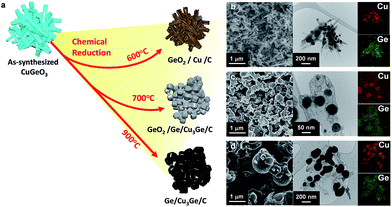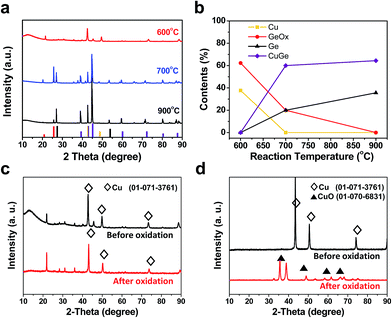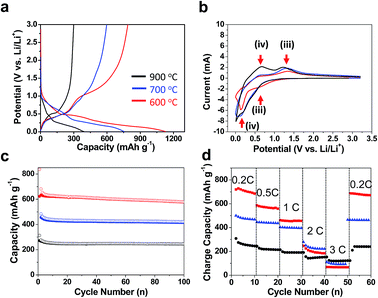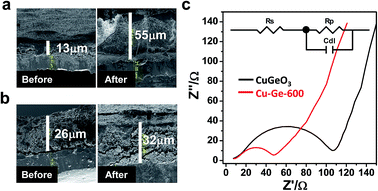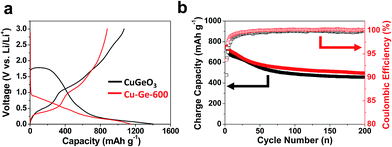Germanium-based multiphase material as a high-capacity and cycle-stable anode for lithium-ion batteries†
Dohyoung Kwon‡
a,
Sinho Choi‡ab,
Guoxiu Wangb and
Soojin Park*a
aDepartment of Energy Engineering, School of Energy and Chemical Engineering, Ulsan National Institute of Science and Technology (UNIST), UNIST-gil 50, Ulsan 689-798, Republic of Korea. E-mail: spark@unist.ac.kr; Fax: +82-52-217-2909; Tel: +82-52-217-2515
bCentre for Clean Energy Technology, Faculty of Science, University of Technology Sydney, NSW 2007, Australia
First published on 12th September 2016
Abstract
Copper germanate has been used in the electrical field and in lithium-ion battery anode applications. The known bonding energies between Cu and O enable us to control the chemical reduction process by thermal decomposition of hydro-carbon gas at high temperature. Herein, we demonstrate the synthesis of germanium-based multiphase materials by a carbothermic reduction process, in which the copper germanate (CuGeO3) single phase material is transformed to multiphase composite materials including Cu, Cu3Ge, GeOx, and Ge by controlling the reaction temperatures. The resulting Ge-based anodes exhibit a reversible capacity of ∼600 mA h g−1, stable capacity retention (80% after 100 cycles at 25 °C and 78% after 200 cycles at 60 °C) at a rate of C/5 with low electrode swelling (23% after 100 cycles). This is a one-step reaction process simultaneously involving reduction, phase transformation, and carbon coating. During the thermolysis reaction, various phases in the material are formed at the interface between Cu and Ge, which can affect the electrochemical performance of the resulting Ge-based anodes.
Introduction
Nowadays, lithium-ion batteries (LIBs) have become commonly used as the power sources of various portable electric devices including smart mobile phones, tablet computers, and wearable devices.1–3 In addition, the market for LIBs will very likely allow progress from small to large size energy storage devices for electric vehicles and smart grid energy storage systems to store electricity generated by renewable energy conversion systems.4,5 The performance of present LIB technology, however, still falls short of the requirements for future transportation and large-size energy storage applications in terms of energy density, power density, safety, charging time, cycle life, and price per unit.6,7In an effort to increase the energy density of LIBs, Li-alloying materials (Si, Sn, and Ge) have been widely studied for the anodes since they meet two requirements of high energy LIBs: higher theoretical specific capacity than that of conventional graphite electrodes (LiC6: ∼372 mA h g−1) and a low working voltage that is close to that of graphite (<0.5 V vs. Li/Li+).8,9 Among these alloying materials, germanium (Ge) has gained much attention as an alternative anode material for advanced LIBs with high energy density; high theoretical capacity (Li22Ge5: 1600 mA h g−1), low operating voltage (0.3 V vs. Li/Li+).10 Furthermore, Ge exhibits ∼400 times higher Li-ion diffusion coefficient at room temperature and higher electronic conductivity (1.45 S m−1), compared to Si.11 However, two major problems of Ge anodes should be solved for practical applications of this Li-alloying anode material. One is a large volume change of electrodes upon alloying/de-alloying, and the other is the formation of unstable solid electrolyte interphase (SEI) layers on the surfaces of active material.12
Several approaches have been made to solve or at least to mitigate the volume-change problem; down-sizing alloying materials,13,14 shape-control of Ge-based materials including one-dimensional (1D) shape,15,16 hollow structures,17 3D porous structure,18 and various synthetic methods (e.g., sol–gel method,19 hydrothermal,17,20 chemical deposition,21 hydrolysis processes22 and composites23–25).
Recently, numerous researchers have demonstrated that various Ge-based alloying materials could improve the performance of LIBs.26,27 For example, Lu's group reported that core–shell type Ge nanofibers made by electro-spinning exhibited a reversible capacity of 1050 mA h g−1 after 100 cycles.26 Kang's group demonstrated the fabrication of long-term stable battery anodes showing a capacity retention of over 90% after 1600 cycles by combining reduced graphene oxide and amorphous GeOx composite material.27
As another strategy, metal germanate battery anodes have been developed, because metal oxide matrix in the metal germanate could provide an elastic buffer to accommodate the volume changes and result in improving the electrochemical performance.28–30 However, a poor initial coulombic efficiency and unsatisfied capacity retention at high temperature should be resolved.
Herein, we demonstrate thermolysis processes that simultaneously facilitate a chemical reduction and a phase transformation of copper germanate (CuGeO3), in which copper germanate (CuGeO3) single phase material is transformed to multiphase composite materials including Cu, Cu3Ge, GeOx, and Ge by controlling reaction temperatures. The resulting Ge-based anodes exhibit a reversible capacity of ∼600 mA h g−1, stable capacity retention (80% after 100 cycles at 25 °C and 78% after 200 cycles at 60 °C) at a rate of C/5 with low electrode swelling (23% after 100 cycles). CuGeO3 material with electromagnetic properties has been used in electrical field applications.31 The known bonding energies between Cu and O enable us to control the chemical reduction process by thermal decomposition of hydro-carbon gas at high temperature. This is one-step reaction process simultaneously involving reduction, phase transformation, and carbon coating. During the thermolysis reaction, various phases in material are formed at the interface between Cu and Ge, which can affect the electrochemical performance of the resulting Ge-based anodes.
Experimental
Synthesis of copper germanate
Nanocrystalline CuGeO3 was synthesized by a hydrothermal process according to the procedure reported by Feng et al.32 with some modifications. In a typical synthesis, 0.364 g of cetyltrimethylammonium bromide (CTAB, Aldrich, >99.9%), 0.52 g of GeO2 (Aldrich, 99.999%), and 0.85 g of CuCl2·H2O (Aldrich, >99.9%) were added to 15.0 mL of distilled water. The pH value of the resulting mixture was adjusted to 8 by adding NaOH (30 wt%). The mixture was stirred for 1 h and then transferred to a stainless Teflon-lined autoclave of 25 mL inner volume with 80% fill ratio. The autoclave was heated to 180 °C and held for 24 h, followed by cooling to room temperature. The product was centrifuged, filtered, and rinsed with alcohol and deionized water for several times. Finally, the product was dried at 80 °C for 12 h in the air. A blue colored CuGeO3 powder was obtained with a yield of about 90%.Carbothermic reduction of copper germanate
The as-synthesized CuGeO3 was placed inside an alumina boat. Subsequently, the hydro-carbon chemical reduction was performed at 600–900 °C (a rate of 5 °C min−1) for 20 min under an argon environment to synthesize a shape-preserving Cu and GeOx composite materials and porous structured Cu–Ge alloy and Ge-based composite materials.Physical characterization
The surface morphologies of nano crystalline CuGeO3 and as-synthesized Cu–Ge composites were characterized using a field-emission scanning electron spectroscopy (FESEM, Hitachi S-4800), which was performed at 10 keV. The microstructures of the CuGeO3 and as-synthesized Cu–Ge composites were investigated using a X-ray diffractormeter (XRD, Bruker D8-Advance), which were performed at 3 kW using Cu Ka radiation.Electrochemical test
The electrochemical properties of the CuGeO3 and Cu3Ge–Ge based composites electrodes were evaluated using coin-type half cells (2016R-type) at 25 °C and 60 °C. The CuGeO3 and Cu3Ge–Ge based electrodes were composed of the each active material, super-P carbon black, and poly (acrylic acid)/sodium carboxymethyl cellulose (1![[thin space (1/6-em)]](https://www.rsc.org/images/entities/char_2009.gif) :
:![[thin space (1/6-em)]](https://www.rsc.org/images/entities/char_2009.gif) 1, w/w) as binder in a weight ratio of 7
1, w/w) as binder in a weight ratio of 7![[thin space (1/6-em)]](https://www.rsc.org/images/entities/char_2009.gif) :
:![[thin space (1/6-em)]](https://www.rsc.org/images/entities/char_2009.gif) 1.5
1.5![[thin space (1/6-em)]](https://www.rsc.org/images/entities/char_2009.gif) :
:![[thin space (1/6-em)]](https://www.rsc.org/images/entities/char_2009.gif) 1.5.
1.5.
The capacity of battery cell was calculated by total mass of active materials in electrode. The proportion of Ge material in active materials was estimated by specific capacities of electrodes. The coin cell consisted of lithium metal as the counter electrode, a polyethylene separator, and 1.3 M LiPF6 containing ethylene carbonate/diethyl carbonate (PANAX starlyte, Korea, 3/7 (v/v)) and 10 wt% fluoroethylene carbonate as the electrolytes. The half cells were tested galvanostatically between 0.005 and 3.0 V (versus Li/Li+) for C rate 0.05–3C. The cell performance was examined using a cycle tester (WBCS 3000 battery systems, Wonatech). For impedance measurement, AC complex impedance analysis with an IVIUM frequency response analyzer was used over a frequency range of 10 mHz to 1 MHz.
Results and discussion
Synthesis and characterization of Ge-based multiphase materials
Fig. 1a shows the schematic illustration of the synthetic routes of various Cu-incorporated Ge-based composite materials at three different reaction temperatures. As-synthesized CuGeO3 nanorods were obtained through a hydrothermal reaction at 180 °C for 24 h. The crystalline CuGeO3 (JCPDS card no. 01-070-6183) showed an average diameter of 70 nm and a length of 0.5–2 μm (ESI, Fig. S1†).Meanwhile, the CuGeO3 can also be used a source material to make other multi-phase materials consisting of Cu, Ge, O and C via thermal decomposition of acetylene gas (C2H2). At a low reaction temperature of 600 °C, shape preserved GeOx/Cu/C composites were synthesized by a carbothermic reduction process. The resulting materials maintained an original nanorod shaped structure with rough surfaces and a thin carbon layer on the surface as shown in the scanning electron microscopy (SEM) image (left in Fig. 1b). Furthermore, the transmission electron microscopy (TEM) image (middle in Fig. 1b) and the energy-dispersive X-ray spectroscopy (EDS) mapping image (right in Fig. 1b) show the decorated Cu nano particles in GeOx nanorods. This result indicates that only Cu and O bonding in CuGeO3 is broken owing to a thermal energy that is not enough to reduce the GeO2 phase. As the reaction temperature is increased to 700 °C, Cu3Ge was formed at the interface of Cu and Ge and GeOx partially reduced to pure Ge33 (Fig. 2a). The resulting Ge/GeOx/Cu3Ge/C composite materials had a porous structure with spherical primary particles all covered by a thin carbon layer on the outer surface (left in Fig. 1c). The TEM image (middle in Fig. 1c) and the EDS mapping image (right in Fig. 1c) show a porous Ge matrix including Cu3Ge particles for high electrical conductivity. Further increase of the reaction temperature (900 °C) led to a full chemical reduction of CuGeO3 to Ge/Cu3Ge/C composite (Fig. 2a). At this temperature, all oxygen elements in the original materials were completely removed by the carbothermic reduction process due to evacuation of by-products such as CO and CO2.34 However, the resulting Ge/Cu3Ge/C composite showed collapsed and aggregated morphologies owing to the high thermal shock as shown in TEM image and EDS mapping images (Fig. 1d).
A Brunauer–Emmett–Teller (BET) analysis indicated that the porous Cu–Ge-600 composite materials had a BET surface area of 12.74 m2 g−1, indicating that numerous mesopores were formed during the carbothermic reduction process. The pore size distribution, obtained using the Barrett–Joyner–Halenda (BJH) method, suggested that the Cu–Ge-600 materials had an average pore size of 14 nm and a narrow pore size distribution (less than 10 nm pore diameter) (ESI, Fig. S2†).
Fig. 2a presents the X-ray diffraction (XRD) patterns of chemically reduced Ge-based multiphase composites obtained at various reaction temperatures. At 600 °C, Cu (JCPDS card no. 01-070-3038) and low intensity GeO2 (JCPDS card 01-074-5906) peaks are clearly observed, respectively. The remarkable reduction of GeO2 peak intensity indicates that amorphous GeOx (oxygen-deficient GeO2) is formed by the carbothermic reduction. As the reaction temperature increases, the peak intensity of GeO2 gradually decreases and simultaneously new phases, Cu3Ge (JCPDS card no. 01-070-3058) and Ge (JCPDS card no. 01089-5011), are developed (Fig. 2a). Based on the results of XRD patterns, all the resulting components have been plotted as a function of reaction temperature (Fig. 2b).
Meanwhile, we investigated the thermal stability of Cu–Ge-600 samples in air at 200 °C for 6 h. The Cu–Ge-600 was not oxidized, owing to carbon coating layers formed on the Cu–Ge surface (Fig. 2c). In contrast, when pure Cu particles were treated in the same oxidation conditions, they were completely converted to copper oxides (Fig. 2d). These results indicate that Ge-based multiphase composites synthesized by the carbothermic reduction process are quite stable under thermal oxidation conditions.
Electrochemical performance of Ge-based multiphase composites
Ge-based multiphase composites (synthesized at three different temperatures) and pristine CuGeO3 materials were tested as lithium-ion battery anodes. The voltage profile and cyclic voltammogram (CV) curves of CuGeO3 nanorod anodes were obtained in the potential window of 0.01–3.0 V (ESI, Fig. S3†). These results show typical cathodic and anodic peaks of both CuO and GeO2, which are in good agreement with previous reports.31 A sharp cathodic peak appeared at ∼1.5 V, which is related to the formation of SEI layers and amorphous Li2O and CuII1−xCuIxO1−x/2 originating from the decomposition of CuGeO3 as the follow equations:35| CuGeO3 + 2Li → Cu + GeO2 + Li2O (1.7 V) | (i) |
| Cu2O + 2Li → 2Cu + Li2O/2CuO + 2Li → 2Cu + Li2O at 1.5 V (∼0.5 V) | (ii) |
| GeO2 + 4Li → Ge + 2Li2O (0.4 V) | (iii) |
| Ge + XLi → GeLiX (0.4 V) | (iv) |
As a result, the CuGeO3 anode shows a poor initial columbic efficiency of ∼68%. When we consider practical full-cell systems, multiple lithiation processes (ranging from 1.75 to 0.005 V) of the CuGeO3 will make the energy density of such full cell to be lower. In this aspect, the reduction process of CuGeO3 is necessary to increase the initial coulombic efficiency and to bring the lithiation voltage as low as possible.
Fig. 3a shows the first cycle voltage profiles of discharging (lithiation) and charging (delithiation) for three Cu–Ge composite anodes at a rate of C/20 in the potential window 0.01–3.0 V. The first discharge capacities of Cu–Ge-600, Cu–Ge-700, and Cu–Ge-900 anodes are 1129, 756, and 388 mA h g−1 with significantly enhanced initial coulombic efficiencies of 77%, 79% and 77%, respectively (Fig. 3a). Increasing reaction temperature leads to the reduction of specific capacity owing to an increased amount of inactive Cu3Ge phase. The CV curve of Cu–Ge-600 electrode shows typical cathodic and anodic peaks of GeOx while Cu–Ge-700 and Cu–Ge-900 profiles are similar to those of typical Ge electrodes36,37 (Fig. 3b).
Three Cu–Ge composite anodes exhibit highly stable cycling performance, corresponding to the capacity retention of 80% (Cu–Ge-600), 91% (Cu–Ge-700), and 90% (Cu–Ge-900) at a rate of C/5 after 100 cycles, respectively (Fig. 3c). Further, both Cu–Ge-600 and Cu–Ge-700 electrodes exhibit superior rate capabilities, which correspond to a charge capacity of ∼480 mA h g−1 at 1C rate (Fig. 3d). Outstanding capacity retention and excellent rate capability of Cu–Ge electrodes may be explained as follows: (i) mesoporous structures have many void spaces which can act as a buffer layer to alleviate a large volume change. (ii) Good mechanical properties of Cu and Cu3Ge retain the structural integrity of mesoporous Cu–Ge during the repeated cycles. (iii) The electrical conductivity of Cu phase in materials will significantly increase the conductivity of Cu–Ge composites. And (iv) the outer carbon layers can form SEI layers on the Cu–Ge composite surface. In contrast, the CuGeO3 electrode showed a poor cycling performance (capacity retention of 82% after 100 cycles) and rate capabilities due to a large volume expansion of the electrode (ESI, Fig. S3c†).
As aforementioned, Cu–Ge anodes with porous structure containing void spaces and Cu phases in composite materials provide an additional buffer matrix for a large volume expansion of Ge particles, which is clearly seen in the cross-sectional SEM images of the electrodes after 100 cycles at a rate of C/5 discharge/charge in Fig. 4. As expected, the Cu–Ge-600 anode showed a remarkably suppressed volume expansion (23%), compared to that of the CuGeO3 anode (320%), as shown in Fig. 4a and b. In addition to the Cu–Ge-600, both Cu–Ge-700 and Cu–Ge-900 also showed a low electrode swelling of 24% and 14%, respectively, owing to the buffer matrix of Cu3Ge and carbon (ESI, Fig. S4†).
To further understand the superior electrochemical performance of Cu–Ge-600, electrochemical impedance spectroscopy (EIS) measurements were performed. The Cu–Ge-600 electrodes showed a slightly lower impedance value (Rct: 33.9 ohm) than that of CuGeO3 (Rct: 84.5 ohm) electrodes due to the reduced Cu phases and oxygen-deficient GeOx (Fig. 5).
We investigated the electrochemical performance of conducting agent-free systems. The Cu–Ge-600 and CuGeO3 anodes were composed of 95% active material and 5% binder without any super P carbon black conducting agent. The Cu–Ge-600 electrode showed a higher specific capacity of 290 mA h g−1 after 20 cycles at a rate of C/2, compared to that of the CuGeO3 electrode (50 mA h g−1). Even though the reversible capacity of Cu–Ge-600 is low, Cu and C matrix in the composite materials may enhance its electrical conductivity in a composite electrode (ESI, Fig. S5†).
For practical LIB applications, an electrochemical test at high temperature is required. We investigated the electrochemical performance of CuGeO3 and Cu–Ge-600 electrodes at 60 °C. The Cu–Ge-600 anode showed a high specific capacity of ∼800 mA h g−1 in the first cycle, and maintained the capacity of ∼500 mA h g−1 (capacity retention of 63%) after 200 cycles at a rate of C/2. In contrast, the CuGeO3 electrode exhibited a charge capacity of ∼1050 mA h g−1 in the first cycle, but a poor capacity retention of 47% after 200 cycles. This result indicates that Cu and carbon matrix in the composite material may induce the formation of stable SEI layers, even though serious electrolyte decomposition occurs at 60 °C.
Conclusion
We successfully synthesized various Ge-based multiphase composite materials via one-step carbothermic reduction processes from CuGeO3. Cu, Cu3Ge, and carbon phases derived from carbothermic reduction of CuGeO3. Also, porous structures of Ge-based composite materials gave additional void spaces which can alleviate large volume changes in Ge-based anodes during lithiation–delithiation processes. As a result, the Ge-based composite anodes showed a high reversible capacity of 590 mA h g−1 after 100 cycles at C/2, excellent rate capability (∼480 mA h g−1 at a rate of 1C), and remarkably suppressed electrode swelling (23%) at 25 °C. Furthermore, it exhibited highly stable cycle retention (63%) after 200 cycles even at 60 °C. We believe that this strategy of Ge-based multiphase composites can establish a milestone for fabricating practical alloy-based materials.Acknowledgements
This work was supported by the National Research Foundation of Korea (NRF) funded by the Ministry of Science, ICT and future Planning (2015R1A2A1A01003143).Notes and references
- L. Ji, Z. Lin, M. Alcoutlabi and X. Zhang, Energy Environ. Sci., 2011, 4, 2682–2699 CAS.
- V. Etacheri, R. Marom, R. Elazari, G. Salitra and D. Aurbach, Energy Environ. Sci., 2011, 4, 3243–3262 CAS.
- W.-J. Zhang, J. Power Sources, 2011, 196, 13–24 CrossRef CAS.
- B. Scrosati, Nature, 1995, 373, 557–558 CrossRef CAS.
- R. F. Nelson, J. Power Sources, 2000, 91, 2–26 CrossRef CAS.
- Y. Nishi, J. Power Sources, 2001, 100, 101–106 CrossRef CAS.
- J. Xu, S. Dou, H. Liu and L. Dai, Nano Energy, 2013, 2, 439–442 CrossRef CAS.
- A. Magasinski, P. Dixon, B. Hertzberg, A. Kvit, J. Ayala and G. Yushin, Nat. Mater., 2010, 9, 353–358 CrossRef CAS PubMed.
- B. Scrosati, J. Hassoun and Y.-K. Sun, Energy Environ. Sci., 2011, 4, 3287–3295 CAS.
- J. Graetz, C. Ahn, R. Yazami and B. Fultz, J. Electrochem. Soc., 2004, 151, A698–A702 CrossRef CAS.
- C. Fuller and J. Severiens, Phys. Rev., 1954, 96, 21–24 CrossRef CAS.
- P. B. Balbuena and Y. Wang, Lithium-Ion Batteries: Solid Electrolyte Interphase, Imperial College Press: World Scientific Publishing Co. Pte. Ltd., London, 2004 Search PubMed.
- J. R. Szczech and S. Jin, Energy Environ. Sci., 2011, 4, 56–72 CAS.
- A. S. Arico, P. Bruce, B. Scrosati, J.-M. Tarascon and W. Van Schalkwijk, Nat. Mater., 2005, 4, 366–377 CrossRef CAS PubMed.
- M.-H. Seo, M. Park, K. T. Lee, K. Kim, J. Kim and J. Cho, Energy Environ. Sci., 2011, 4, 425–428 CAS.
- C. K. Chan, X. F. Zhang and Y. Cui, Nano Lett., 2008, 8, 307–309 CrossRef CAS PubMed.
- T. Lv, X. Li and J. Ma, RSC Adv., 2014, 4, 49942–49945 RSC.
- M. H. Park, K. Kim, J. Kim and J. Cho, Adv. Mater., 2010, 22, 415–418 CrossRef CAS PubMed.
- J. Hwang, C. Jo, M. G. Kim, J. Chun, E. Lim, S. Kim, S. Jeong, Y. Kim and J. Lee, ACS Nano, 2015, 9, 5299–5309 CrossRef CAS PubMed.
- J. Feng, M. Lai and L. Lu, Electrochem. Commun., 2011, 13, 287–289 CrossRef CAS.
- J. L. Lensch-Falk, E. R. Hemesath, F. J. Lopez and L. J. Lauhon, J. Am. Chem. Soc., 2007, 129, 10670–10671 CrossRef CAS PubMed.
- H. Miguez, F. Meseguer, C. Lopez, M. Holgado, G. Andreasen, A. Mifsud and V. Fornés, Langmuir, 2000, 16, 4405–4408 CrossRef CAS.
- L. Yuan, H. Yuan, X. Qiu, L. Chen and W. Zhu, J. Power Sources, 2009, 189, 1141–1146 CrossRef CAS.
- L. Shen, X. Zhang, E. Uchaker, C. Yuan and G. Cao, Adv. Energy Mater., 2012, 2, 691–698 CrossRef CAS.
- J. Liu, W. Li and A. Manthiram, Chem. Commun., 2010, 46, 1437–1439 RSC.
- X. Wang, L. Fan, D. Gong, J. Zhu, Q. Zhang and B. Lu, Adv. Funct. Mater., 2016, 26, 1104–1111 CrossRef CAS.
- S. H. Choi, K. Y. Jung and Y. C. Kang, ACS Appl. Mater. Interfaces, 2015, 7, 13952–13959 CAS.
- J. Wang, C.-Q. Feng, S.-L. Chou, H.-K. Liu and J.-Z. Wang, Sci. Rep., 2014, 4, 7030 CrossRef CAS PubMed.
- C. H. Kim, Y. S. Jung, K. T. Lee, J. H. Ku and S. M. Oh, Electrochim. Acta, 2009, 54, 4371–4377 CrossRef CAS.
- W. Li, Y.-X. Yin, S. Xin, W.-G. Song and Y.-G. Guo, Energy Environ. Sci., 2012, 5, 8007–8013 CAS.
- M. Hase, I. Terasaki and K. Uchinokura, Phys. Rev. Lett., 1993, 70, 3651 CrossRef CAS PubMed.
- J. Feng, M. O. Lai and L. Lu, Mater. Res. Bull., 2012, 47, 1693–1696 CrossRef CAS.
- R. W. Olesinski and G. J. Abbaschian, J. Phase Equilib., 1986, 7, 28–35 CAS.
- S. Choi, J. Kim, D. Y. Hwang, H. Park, J. Ryu, S. K. Kwak and S. Park, Nano Lett., 2016, 16, 1179–1185 CrossRef CAS PubMed.
- S. Wu, R. Wang, Z. Wang and Z. Lin, Nanoscale, 2014, 6, 8350–8358 RSC.
- X. Liu, J. Hao, X. Liu, C. Chi, N. Li, F. Endres, Y. Zhang, Y. Li and J. Zhao, Chem. Commun., 2015, 51, 2064–2067 RSC.
- W. He, H. Tian, X. Wang, F. Xin and W. Han, J. Mater. Chem. A, 2015, 3, 19393–19401 CAS.
Footnotes |
| † Electronic supplementary information (ESI) available: Characterization of copper germanate, BET surface area, and electrochemical test. See DOI: 10.1039/c6ra19811b |
| ‡ These authors equally contributed to this work. |
| This journal is © The Royal Society of Chemistry 2016 |

